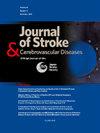Intracarotid injection of hyperosmolar mannitol produced a larger infarct than normal saline during the first few hours of distal middle cerebral artery occlusion with a smaller regional plasma volume
IF 1.8
4区 医学
Q3 NEUROSCIENCES
Journal of Stroke & Cerebrovascular Diseases
Pub Date : 2025-07-19
DOI:10.1016/j.jstrokecerebrovasdis.2025.108403
引用次数: 0
Abstract
Background
Although hyperosmolar mannitol has been used clinically to reduce intracranial pressure, its use in acute ischemic stroke remains controversial. We investigated whether other characteristics of hyperosmolar mannitol such as its effects on cerebral regional plasma volume or blood-brain barrier permeability would affect infarct size when intracranial pressure is zero during the early ischemic stroke.
Methods
One hour after a distal middle cerebral artery occlusion with craniotomy which results in essentially zero intracranial pressure, the rats were treated with 25 % mannitol or normal saline via the ipsilateral external carotid artery. Control rats received no treatment. Two hours after middle cerebral artery occlusion, infarct size along with the blood-brain transfer coefficient of 14C-α-aminoisobutyric acid, and the volume of 3H-dextran distribution were measured to assess blood-brain barrier permeability and plasma volume respectively.
Results
At one hour after intracarotid artery injection and two hours after middle cerebral artery occlusion, hyperosmolar mannitol treatment significantly reduced cerebral regional plasma volume in the ischemic cortex (3.0 mL/100 g ± 1.6) compared to normal saline (6.1 mL/100 g ± 1.3, p < 0.0001) or no treatment (4.8 mL/100 g ± 1.2, p < 0.05). Blood-brain barrier permeability was similar regardless of treatments in the ischemic cortex. The percentage of cortical infarcted area relative to total cortical area was significantly higher in the mannitol-treated rats (14.0 % ± 4.5) compared to normal saline treatment (6.6 % ± 1.4, p < 0.01).
Conclusions
Our findings suggest that when intracranial pressure effect is excluded, hyperosmolar mannitol may exacerbate neuronal damage in the very early stages of acute ischemic stroke, and that cerebral regional plasma volume plays an important role in neuronal survival.
颈动脉内注射高渗甘露醇在大脑中远端动脉闭塞的最初几个小时内产生比生理盐水更大的梗死,区域血浆容量较小。
背景:虽然高渗甘露醇在临床上用于降低颅内压,但其在急性缺血性脑卒中中的应用仍存在争议。我们研究了当颅内压为零时,高渗甘露醇对脑区域血浆容量或血脑屏障通透性的影响是否会影响早期缺血性脑卒中的梗死面积。方法:大鼠大脑中远端动脉闭塞开颅后1小时,颅内压基本为零,经同侧颈外动脉给予25%甘露醇或生理盐水。对照大鼠不接受任何治疗。阻断大脑中动脉2 h后,分别测定梗死面积随14C-α-氨基异丁酸血脑转移系数和3h -葡聚糖分布体积,评价血脑屏障通透性和血浆容量。结果:颈动脉内注射后1小时和大脑中动脉闭塞后2小时,高渗甘露醇治疗显著降低脑缺血皮质区域血浆体积(3.0 mL/100g±1.6),低于生理盐水(6.1 mL/100g±1.3,p < 0.0001)或未治疗(4.8 mL/100g±1.2,p < 0.05)。血脑屏障通透性是相似的,无论治疗的缺血皮质。甘露醇组大鼠皮质梗死面积占总皮质面积的比例(14.0%±4.5)明显高于生理盐水组(6.6%±1.4,p < 0.01)。结论:在排除颅内压作用的情况下,高渗甘露醇可加重急性缺血性脑卒中早期的神经元损伤,脑区域血浆容量对神经元存活起重要作用。
本文章由计算机程序翻译,如有差异,请以英文原文为准。
求助全文
约1分钟内获得全文
求助全文
来源期刊

Journal of Stroke & Cerebrovascular Diseases
Medicine-Surgery
CiteScore
5.00
自引率
4.00%
发文量
583
审稿时长
62 days
期刊介绍:
The Journal of Stroke & Cerebrovascular Diseases publishes original papers on basic and clinical science related to the fields of stroke and cerebrovascular diseases. The Journal also features review articles, controversies, methods and technical notes, selected case reports and other original articles of special nature. Its editorial mission is to focus on prevention and repair of cerebrovascular disease. Clinical papers emphasize medical and surgical aspects of stroke, clinical trials and design, epidemiology, stroke care delivery systems and outcomes, imaging sciences and rehabilitation of stroke. The Journal will be of special interest to specialists involved in caring for patients with cerebrovascular disease, including neurologists, neurosurgeons and cardiologists.
 求助内容:
求助内容: 应助结果提醒方式:
应助结果提醒方式:


